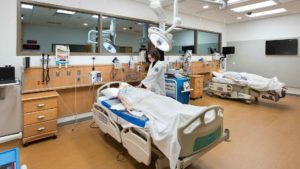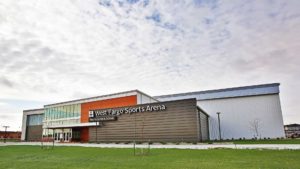Minot State University students will have a unique opportunity to study the human body as the university officially opened a cadaver lab to enhance its Biology 220 and 221 Anatomy and Physiology I and II classes.
The cadaver lab – one of only two such labs at public institutions in North Dakota – has two stations for dissection and an observation room. The lab was built in response to a request from Minot State students for hands-on learning experiences.
“We would be in class and teaching a topic and I would say it would be really nice to show you this, but we just don’t have the facility. Instead we would use plastic models or dissected animals,” said Minot State biology instructor and cadaver lab supervisor Dr. Aaron Ament. “It was really frustrating at times; we could lecture, but not observe. The students came to me and said maybe we should write a letter to the president or express our concerns to student government. I told them I would support that, and it basically started from there.”
Minot State partnered with the University of North Dakota School of Medicine & Health Sciences to receive the cadavers. The lab will consist of one male and one female cadaver each academic year.
“Each year, we see students graduate from Minot State who move on to advanced professional schooling such as medical school,” said Minot State President Steven Shirley. “The installation of this new lab at MSU will enhance our curriculum and further prepare our students for the next steps in their educational and career endeavors.”
There are strict rules and regulations that accompany the new cadaver lab.
“There are a lot of rules that we will need to follow from certain types of clothing that can be worn, to no video or photography, to what we do with the tissue,” Ament said. “Everything is supervised. There is a long list of procedures. A lot of what we are working on right now is implementing those procedures.”
According to Ament, the experience gained through working with cadavers as opposed to plastic models is immeasurable.
“My first opportunity to work on a cadaver was as an undergrad, and there is real benefit to being able to touch and feel actual tissue,” he said. “But it goes beyond that. It’s a little metaphysical. The experience is so vivid, it’s something you will remember and appreciate as you continue on in biology. It’s humans dissecting a human. It’s one of those big picture items; you can take in account how they died. In our case, one of the individuals had heart disease. Once we are to that point in the dissection, we can actually see what caused that event.”
While Ament believes his biology students will leave Minot State better prepared for their next level of school, he also feels other disciplines within the university will benefit from the class.
“I really think this can be applied in multiple areas,” he said. “In a lot of places, nursing students don’t get the opportunity to work on cadavers. Individuals who are studying art, for another example, if they are thinking of becoming a medical illustrator, can actually see the bones and muscles. Even the athletes on campus can see and understand why certain injuries happen. It will give everyone a better understanding of the human body, in whatever subject they are studying.”
And, for the biology students – especially the individuals interested in a pre-medical field – there are real advantages to working in Minot State’s smaller classes.
“We will offer the lab experience of a medical school, but at a much smaller undergraduate class size,” Ament said. “We will really be able to teach the subject.”
ABOUT MINOT STATE UNIVERSITY
Minot State University is a public university dedicated to excellence in education, scholarship, and community engagement achieved through rigorous academic experiences, active learning environments, commitment to public service, and a vibrant campus life.



